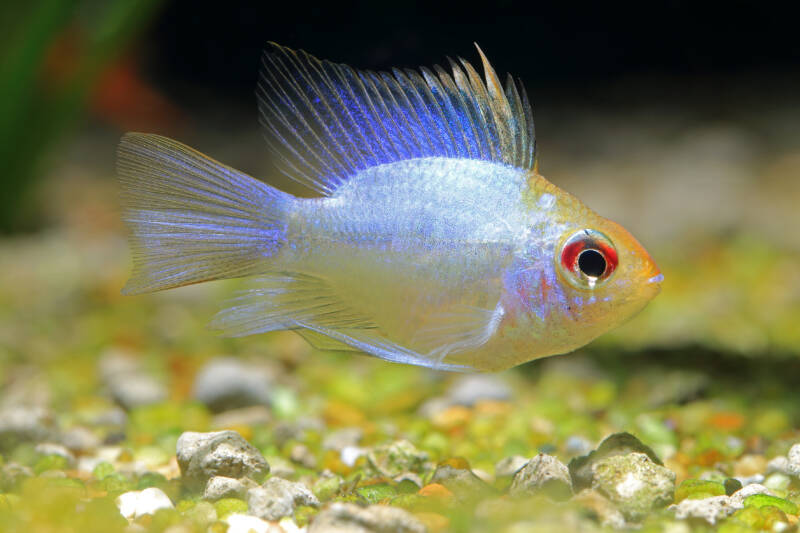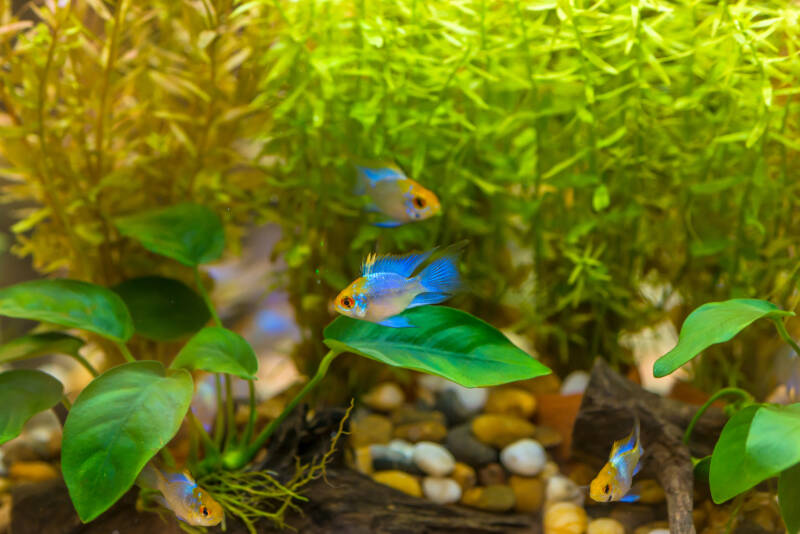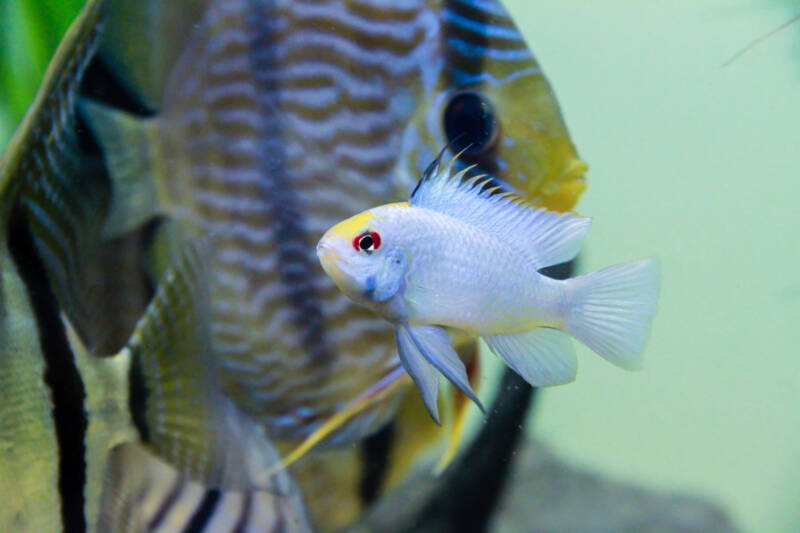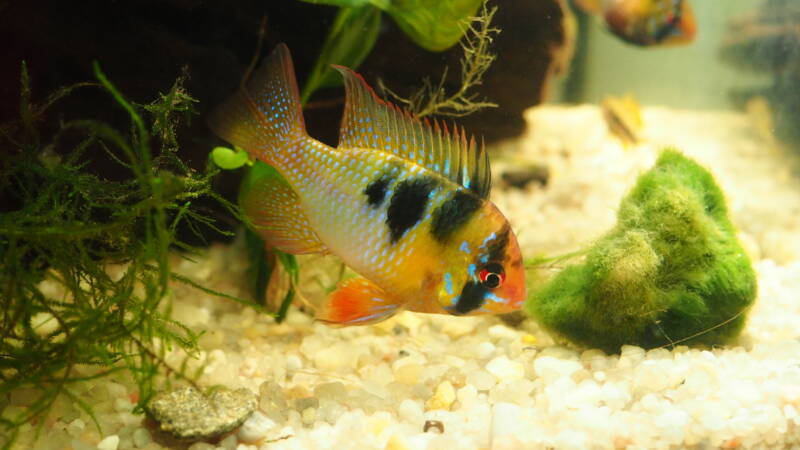Ram cichlids (Mikrogeophagus ramirezi) make popular alternatives for aquarists who love cichlids but don’t have a lot of tank space.

Members of the dwarf cichlid group, these gorgeous fish require less room than some of their larger counterparts.
Ram cichlids come in a variety of stunning colors. The flashing yellows, blues, and greens appeal to any discerning eye.
Those shades have also prompted several common names: blue rams, butterfly cichlids, and electric blue rams.
The flashy color display warns off potential predators.
Ram cichlids also boast an impressive array of spiny rays along their dorsal fins as an added defense. If a larger fish attempts to swallow them, the spines hook into the predator’s throat.
Unhappily, ram cichlids have some demanding care needs. This makes them a little too challenging for novice aquarists.
You’re better off waiting to incorporate these cichlids into your community until you’ve gained experience and expertise.

At a Glance
- Lifespan: 2-4 years
- Size: 2-3 inches (5-8 cm)
- Tank Size: 20 gallons (75 l)
- School Size: Alone or in pairs
- Temperature: 78-85°F (26-29°C)
- pH: 6.0-7.5
- Hardness: 6-14 dH
- Ammonia: 0 ppm
- Nitrite: 0 ppm
- Nitrate: < 30 ppm
[toc]
In the Wild
As a dwarf cichlid, ram cichlids have a suitably “small” native range. You’ll find this beautiful fish contained in the Orinoco River basin.
Of course, the Los Llanos, or “flat plains” of the basin, stretch through Columbia and Venezuela.
Rams prefer slow-moving waters with dense plant cover. They gravitate towards dimmer waters, where the decaying greenery stains everything a tea color.
You’ll also see much higher temperatures than most fish tolerate – as high as 84-86°F (29-30°C).
Many people see these colorful freshwater fish listed as German blue rams and assume they must have a European branch.

However, the German blues represent a color variety. Selective breeding took place in Germany, which is how they earned their name.
Size: the Tiny Cichlid
Ram cichlids fall under the “dwarf cichlid” group. This means they don’t grow very large, even as adults.
The maximum length you’re likely to see is around 2-3 inches (5-7 cm). Many aquarists gravitate to this “manageable” cichlid size.
Lifespan

Unfortunately, ram cichlids don’t have a very long lifespan. On average, they live between 2-4 years.
Most rams die early due to poor captive-breeding practices or improper husbandry. Even wild-caught rams can suffer shorter lifespans if not taken care of properly.
If you want to maximize your ram cichlid’s chances, you need to stay on top of your water conditions.
Rams have specific temperature needs, in particular, that need to be met. You’ll also need to provide a high-quality diet.
Behavior

Unlike most cichlids, ram cichlids lack that stereotypical aggressive streak (outside of spawning season).
They establish a territory within the tank, but they’re more peaceful than their larger cousins.
Rams do well on their own, or you can keep them in pairs. If you choose to keep a male and female together, your best chance lies in allowing them to pair up naturally.
Forced relationships don’t work very well in ram cichlid circles.
Ram males CAN work out together, but you need proper tank space. Each male needs a territory of his own.
Pet stores may mislead you into thinking two juvenile males get along as they tolerate each other in a small tank. Don’t believe the hype!
In pet store situations, fish often find themselves thrust together for the first time.
It isn’t so much a lack of aggression as they’re struggling to get used to the tank. As the males settle in – and mature – you’ll see problems develop without proper space.
Tank Setup

While on the small side, ram cichlids require adequate space to remain healthy and active. If you want to keep your fish in tip-top shape, never go smaller than a 20-gallon (70 l) tank.
And if you plan to have a community, a minimum of a 30-gallon (114 l) tank is required.
Ram cichlids WON’T tolerate a build-up of waste in their aquarium. This makes the selection of a filter crucial.
You want to balance waste removal with minimal water outflow. Any of the following options work well for rams:
Water Conditions

One of the biggest mistakes novice aquarists make with ram cichlids is keeping the water temperature too low.
These dwarf cichlids prefer the higher end of the thermometer: 78-85°F (26-29°C).
In fact, you can go as high as 84-86°F (29-30°C) without a problem. Of course, you need to make sure any other fish in your aquarium tolerate that kind of warmth.
But if temps drop too low, your rams will suffer decreased immunity and end up with infections.
Invest in a quality heater, such as the Fluval E Electronic Heater or Cobalt, for smaller setups.
Rams also prefer soft, acidic water. You want a pH within the range of 6.0-7.5 and hardness around 6-14 dH.
If you find yourself struggling with hard tap water, look into investing in a RO/DI system to supplement the tank.
If you want a less expensive alternative, you can add Indian almond leaves or alder cones to your tank.

These natural plant materials help soften the water, but they also add natural tannins that will stain the water the tea color rams prefer.
Decorating the Ram Cichlid Tank

As with any other cichlid species, rams tend to dig into the substrate. Providing them with a sand substrate will allow them to behave normally.
The sand will settle back out when they’ve finished, saving you from having to smooth out gravel every other day.
In the wild, rams gravitate to pools and rivers with dense plant cover. The greenery makes them feel safe and provides places to hide.
You want to recreate that security while balancing out their need to redecorate the tank every five minutes.
Java fern and certain mosses don’t require substrate for their roots to anchor into, solving a problem of drifting plants.
Otherwise, you can tuck sturdy plants along the back and sides of the tank to leave your rams swimming room.
Heat-resistant, sturdy plants include:
- Amazon sword
- Anubias
- Cryptocoryne
- Hornwort
- Java fern
- Sagittaria
- Vallisneria
- Water Wisteria.
Additions such as driftwood, flat river rocks, and caves will make your rams feel at home.

They appreciate hiding places for when they get nervous. Make sure you leave plenty of open swimming room, though.
Ram Cichlids in Communities

As peaceful members of the cichlid family, rams make ideal additions to community aquariums. They need like-minded tank mates, though.
If paired up with larger, aggressive fish, they’ll spend all their time cowering in the weeds.
Tank Mates

Fish with a tolerance for those crucial high temperatures do well with rams.
You want to find companions roughly the same size. Anyone smaller may end up a snack, and those that get larger may be too intimidating.
You also want to consider swimming speed. If your tank mates outcompete your rams for food, they can quickly starve.
Some of the best tank mates for rams include:
- Angelfish
- Bolivian rams
- Cardinal tetras
- Clown loaches
- Corydoras
- Discus
- Dwarf gouramis
- Guppies
- Honey Gouramis
- Kuhli loaches
- Mollies
- Neon tetras
- Platies
- Plecostomus
- Rummy nose tetras
- Silver dollars.

As a smaller fish, you can also combine rams with freshwater shrimp and snails.
Just be careful if you’re trying to breed your shrimp as your rams will happily feed on all of the baby shrimp produced.
Incompatible Species
Unfortunately, the aggressive South American cichlids don’t pair well with rams. They’re just too large and too much of bullies to play nicely.
And any fish large enough to swallow your ram (or attempt to swallow – remember those spines) isn’t a good idea.
And when adding your invertebrates to your tank, consider mouth size.
If THEY’RE small enough to fit in your ram’s mouth, they could end up on the menu. Rams are omnivores, and they won’t hesitate to snap up an easy snack.
Full-grown Amano, bamboo, and vampire shrimp should be fine paired with rams.
Diet and Feeding

While omnivores, getting ram cichlids to eat when first added to a tank can get tricky.
They tend toward the fussy side, and they may go on hunger strikes.
You may not be doing anything wrong. Give them time to settle and choose the best of the following menu options.
Omnivore-specific commercial foods do fine as the base of a ram’s diet.
Omega One Freshwater Flakes or Fluval Vegetarian Flakes make excellent choices. (If you read the label, Fluval has plenty of meat in their ingredients). A few pinches a day works fine.
Then you need to settle on a quality protein source. Switch between live, freeze-dried, and frozen to keep your fish interested.
Once a day is plenty, once your rams reach adulthood. They love any of these options:
- Brine shrimp
- Bloodworms
- Cyclops
- Mysis shrimp
- Tubifex worms.
You also want to sprinkle in vegetables every day.
Make sure you peel them first as fish have trouble breaking down that outside cell wall.
Then dip them in a quick boil (called blanching) before cutting them into appropriately sized pieces.
Breeding: Trial and Error
Breeding ram cichlids isn’t particularly difficult. If you have a friendly pair, odds are they’ll start the process without you.
Having everything work through successfully may take a few attempts, though. (Not everyone gets it right the first time)
Males or Females?
Ram cichlids exhibit sexual dimorphism in size, fin shape, and color. This makes it easy to tell the two apart.
If you catch them during the spawning season, it’ll make things even easier, as the colors will be at their most prominent.
Male cichlids get larger than females and have a slimmer profile. They have a forehead that’s rounder in shape.
The pectoral fins reach twice as long, with the tips extending almost to the caudal fin.
And if you look at the second ray on the dorsal fin, it stretches up higher.

In contrast, females are smaller and stockier. The slope of the forehead comes down to a point.
The pectoral fins are shorter, as well; they only come back to around the anal fin.
And while they still have prominent rays on their dorsal fins, they’re roughly the same length.
As for color, females have pinkish-orange shading along their bellies. This becomes very noticeable when they’re ready to breed.
And if you look at the black spot on their side, you’ll see a few iridescent blue scales inside.
The spots on a male are flat, matte black.
If at First You Don’t Succeed…
Ram cichlids WILL breed in a community tank. They’ll find a corner to protect and defend from the other fish.
If you want to maximize your chances of success, though, you should set up a separate breeding tank.
In this case, a 10-gallon (40 l) tank works fine. Sponge filters work best as they’ll prevent the fry from getting sucked into the intake.
You should also invest in automatic timers for your lights.
An irregular day/night schedule may confuse your rams, preventing successful breeding.
You want to provide plenty of cover, so they feel secure, and you’ll need several flat rocks the pair can use to attach their eggs to.
You also want to add Java fern or Java moss to the tank. This provides a source of infusoria that tells the pair their fry will have food.
Gradually increase the water temperature to 84°F (29°C) by 1-2 degrees each day. Provide the parents with live brine shrimp.
The change in temperature and abundance of healthy food triggers the spawning instinct.
The eggs attach to the chosen flat surface. In 3-5 days, the fry hatch, and both parents take up watch over them.
If one happens to swim off, a parent will gently scoop it up in the mouth and return it to the “nursery.”
Health & Disease
Ram cichlids don’t tolerate poor water quality AT ALL. Even 1 ppm of ammonia is enough to kill a fish!
If you don’t stay on top of your tank’s health, these delicate fish may succumb to:
- Flatworms
- Ich
- Parasites
- Skin flukes.
And, unfortunately, rams have a high tendency to contract fish tuberculosis. Mycobacterium marinum is a free-swimming bacteria that occurs in fresh and saltwater.
Fish that contract the disease may develop:
- Weight loss
- Ulcers
- White nodules
- Dropsy.
This IS a zoonotic disease! If you suspect a case of fish tuberculosis in your tank, make sure you wear elbow-length gloves before placing your hand in the water.
Veterinary-prescribed antibiotics may treat your fish, but you’ll need to sterilize your tank COMPLETELY.
Ram Cichlids: Are They for You?
Courtesy of captive-breeding programs, ram cichlids come in at a moderate price of $7 – $8 a fish.
Even if you opt for one of the more dramatic color varieties, you shouldn’t have to spend too much to bring home one of these dwarf cichlids.
Unfortunately, if you don’t stay on top of their specific husbandry needs, you could find yourself looking for replacement fish.
This is why it’s recommended that only experienced aquarists attempt to take on these beautiful little fish.
The Other Dwarf Cichlid
While stunning to look upon, ram cichlids have demanding care needs.
These delicate little fish may otherwise end up perishing too soon.
If you’re at the top of your game, though, you couldn’t ask for a lovelier addition to your tank.
Do you keep ram cichlids? What temperature do you keep your tank at?
Have you successfully bred a pair?
Let us know your stories and questions here!
